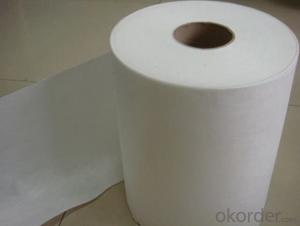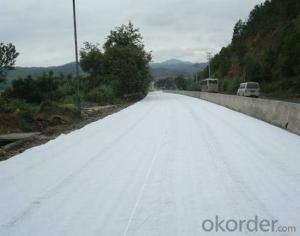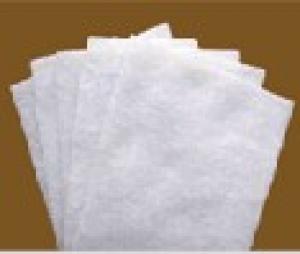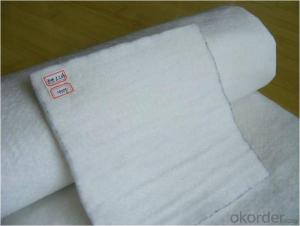Geotextile Membrane Toolstation Filament Non-Woven Geotextile for Railway Construction
- Loading Port:
- Qingdao
- Payment Terms:
- TT OR LC
- Min Order Qty:
- 20000 m²
- Supply Capability:
- 1500000 m²/month
OKorder Service Pledge
OKorder Financial Service
You Might Also Like
Features of Filament Non-woven Geotextile for Railway Construction:
1) Staple fibers needle punched non woven geotextile
The geotextile is made of polypropylene staple fibers on cross-laying equipment and needle punched equipment. It owns the advantages of acid and alkali resistance, erosion resistance, aging resistance, large strength, stable size, good filtrability etc.
2) Filament non woven geotextile
Filament geotextile has features as follows: High strength, good capacity of elongation and high biology tolerance, alkali tolerance, acidity tolerance, weather resistance good filtration and fine drainage capacity etc. Also it is of low cost, easy in construction and use effects.
Applications of Filament Non-woven Geotextile for Railway Construction:
1) Filtration :
The filtration layer of the dykes, river canal, seacoast, concrete slope, retaining walls. At the same time of preventing the clay granule from passing, it allows the water and the gas pass through freely.
2) Separation :
The isolation of the railway dregs and the roadbed, roadbed and the soft base, surface of the airdrome and parking lot and the groundsill, different dam materials. It isolates the soil and the gravel of two kinds different granule pathway from the groundsill or other buildings.
3) Adding muscle :
The highway, railway, soil-stone dam, breakwater, airport, backfill soil of retaining wall, slope protection, etc in which distributes the earth stress, prevents the side-displacement of the earth body and improves the earth body stability.
4) Protection :
It prevents the bank from being washed out, protects the bank and the bottom, prevents the water and soil from being washed away.
FAQ:
What is the main application of Filament Non-woven Geotextile for Railway Construction?
The main application of our Filament Non-woven Geotextile is as follows: The highway, railway, soil-stone dam, breakwater, airport, backfill soil of retaining wall, slope protection, etc.
Where is your main market?
Our main market is in Middle East, South America and some African countries.
What is your advantages for Filament Non-woven Geotextile for Railway Construction?
One of the largest manufacturer of Filament Non-woven Geotextile for Construction with advanced equipment, big production capacity and excellent quality.



- Q: How do geotextiles help in the reinforcement of soil?
- Geotextiles help in the reinforcement of soil by providing a stable and strong foundation. They act as a barrier against erosion, distribute load uniformly, and improve soil stability by preventing the mixing of different soil layers. Additionally, geotextiles enhance the drainage system, reduce moisture content, and promote healthy vegetation growth, which ultimately strengthens the soil structure.
- Q: How do geotextiles contribute to the efficiency of drainage systems?
- Geotextiles contribute to the efficiency of drainage systems by acting as a filter and separator. They prevent fine particles from clogging drainage pipes and channels, allowing water to flow freely. Additionally, geotextiles help in water infiltration and retention, improving overall drainage performance and reducing the risk of soil erosion.
- Q: How do geotextiles help with load distribution in pavement systems?
- Geotextiles help with load distribution in pavement systems by creating a stable and uniform base layer. They distribute the load from vehicles and heavy traffic across a wider area, reducing the stress on the underlying soil. This prevents the formation of potholes, cracks, and other pavement failures, leading to improved durability and longer lifespan of the pavement system.
- Q: Geotextile tensile strength of the maximum load is generally how much
- What specifications of the geotextile? Is the filament or the short wire or the woven geotextile?
- Q: U400 geotextile u400 what it means
- Is not 400g / ㎡ of geotextile? My company specializes in the production of geotextiles, details (hand) to see capital (machine) material
- Q: Such as the title, the drawings are written on the weaving geotextile, the list is written on the blended geotextile cloth laying / 120g / m2 weaving geotextile, who can tell ah !!!!!!!!!! Urgent more
- Or geotextile ah
- Q: Health geotextile how much money ah?
- Health geotextile, also known as geotextile, it is made of synthetic fibers through the needle or woven from the permeability of geosynthetics. Finished cloth for the cloth, the general width of 4-6 meters, the length of 50-100 meters. The price according to the weight and standard to set, weight (80-1500g / ㎡), the quality standard is a requirement, divided into non-standard, whitening A, Sinochem, the general national standard, Paul national standard, Wait. Ton price is generally between 4900-7500 yuan / ton, but the weight <200g, an increase of 100 yuan / ton; weight> 800g, an increase of 500 yuan / ton. 187 & lt; 6600 & lt; 5604
- Q: Polyester filament nonwoven is filament geotextile
- Yes, generally do geotextile material, polyester filament nonwoven fabric refers to filament geotextile. Huazhi geotechnical materials manufacturers to answer your questions
- Q: 3923.1 why not apply to geotextiles
- Geotextile price, geomembrane price, composite geomembrane price can be found tgcl1123 to see
- Q: What are the primary applications of geotextiles?
- Geotextiles are primarily used in civil engineering and construction projects for applications such as soil stabilization, erosion control, filtration, drainage, and reinforcement of soils. They can also be used in environmental projects, agriculture, and transportation infrastructure.
Send your message to us
Geotextile Membrane Toolstation Filament Non-Woven Geotextile for Railway Construction
- Loading Port:
- Qingdao
- Payment Terms:
- TT OR LC
- Min Order Qty:
- 20000 m²
- Supply Capability:
- 1500000 m²/month
OKorder Service Pledge
OKorder Financial Service
Similar products
Hot products
Hot Searches
Related keywords


































